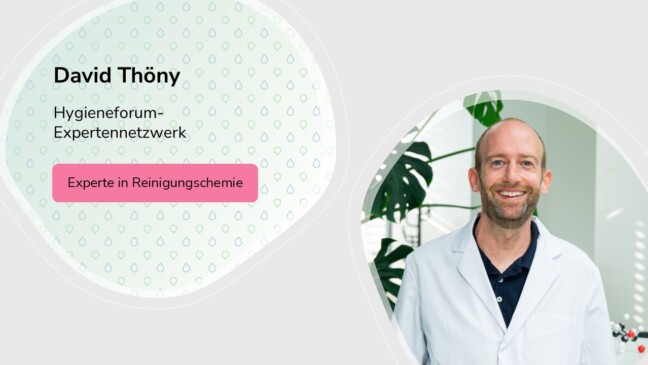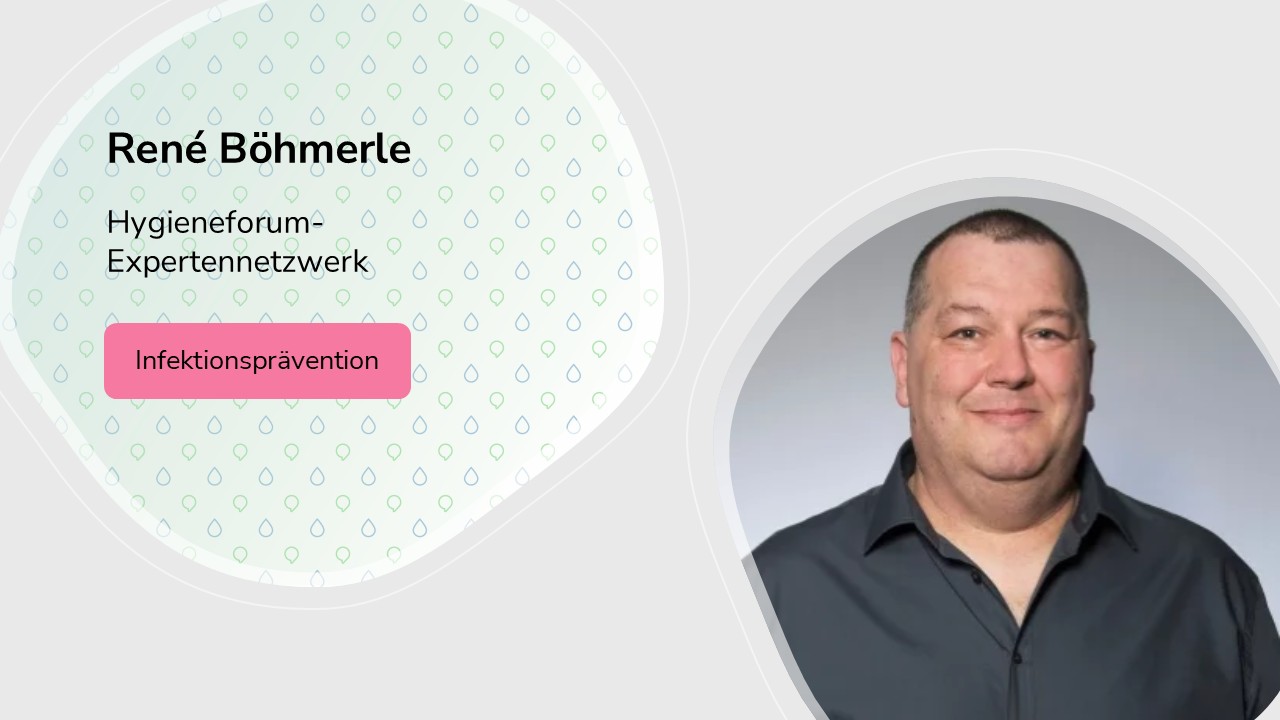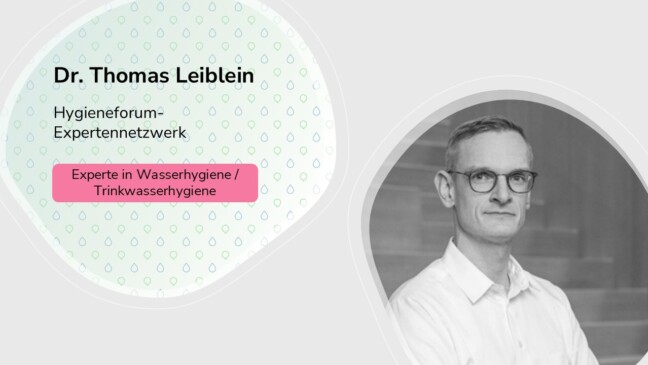
28.10.25
From emergency services to hospital hygiene: René Böhmerle on the challenges and future of infection prevention
René Böhmerle, member of the Hygieneforum.ch expert network, has had an impressive career spanning emergency services, intensive care and hospital hygiene. Today, he advises healthcare facilities on the implementation of effective hygiene concepts and warns of the underestimated risks of poor compliance and multi-resistant pathogens. In this interview, he explains why prevention is essential, what challenges hospitals currently face and how new technologies will change infection prevention.

René Böhmerle is a specialist in infection prevention in healthcare (HFP) with a federal diploma and has many years of experience in the hospital sector, particularly in intensive care medicine/IMC and anaesthesia. After completing his management training and taking on management roles in 2007, he specialised in infection prevention in 2015. Today, through B&B Hygieneberatung GmbH, René Böhmerle supports healthcare facilities in the development and implementation of practical hygiene concepts, conducts audits and helps teams to integrate infection prevention into everyday clinical practice in a sustainable manner.
Mr Böhmerle, your career has taken you from everyday clinical practice to consulting. Could you briefly describe your career path and what motivated you to specialise in hygiene and infection prevention?
I knew early on that I wanted a career where I could help others. At the age of 14, I joined the volunteer fire brigade in my hometown.
My professional career began in 1987, when I enlisted in the German Armed Forces for eight years. There, I completed my training as a paramedic and worked in the emergency room at the German Armed Forces Hospital in Ulm, responding to calls in the SAR Ulm 75 rescue helicopter. After several years in the emergency medical services, I decided to train as a nursing specialist in 1998. I quickly realised that normal nursing offered me too little variety, so I completed further training to become a specialist nurse in anaesthesia and intensive care medicine. I then had the opportunity to take on a management position in an intensive care unit, which is why I went on to study management and became a specialist in organisation and leadership in social services.
In 2007, I was given the opportunity to set up an intermediate care ward as ward manager at the Cantonal Hospital in Baden. Once this had been successfully implemented, I found my way into hygiene. My wife was already working in this field, which allowed me to gain initial experience and develop an interest in infection prevention. Motivated by this, I eventually completed the higher professional examination to become a specialist in infection prevention in healthcare. The topic of hygiene had been with me for some time, and I eventually caught my wife’s passion for infection prevention, although in this context, catching something is considered a positive thing!
Current challenges
Where do you currently see the greatest challenges for hospitals and care facilities in the area of infection prevention?
In my view, the shortage of skilled workers and high staff turnover, particularly among nursing staff and hygiene specialists, currently represent the greatest challenge. This puts a strain on existing teams and makes it difficult to implement measures that are necessary for high quality and hygiene standards. Experience has shown that the language barrier also plays a role for employees who do not have English as their mother tongue. They are usually very motivated, but need more time for training and instruction due to language problems. An additional challenge is the increasing complexity of the patient clientele due to multimorbidity and ever earlier transfers to follow-up institutions such as rehabilitation clinics, nursing homes or Spitex care. In combination with the factors already mentioned, this leads to extremely difficult conditions for the implementation of preventive measures. The tense financial situation and the resulting cost pressure in many institutions exacerbates the tension between cost efficiency and the resources required for hygiene measures. Unfortunately, calculations are often very short-sighted and do not take into account that prevention costs money but saves enormous costs in the long term. A discussion of the ethical aspects of this topic would go beyond the scope of this article…
In your opinion, what factors make it difficult to implement effective hygiene measures?
Firstly, I would mention the lack of compliance. Despite clear guidelines, compliance with standardised measures such as hand hygiene and isolation measures is often not guaranteed in stressful situations or when workloads are high.
The interfaces between the individual areas and institutions pose a constant challenge. Experience shows that inadequate interprofessional communication and cooperation between nursing, therapy, medical staff, housekeeping, cleaning and logistics often leads to errors. In addition, the effects of a lack of prioritisation of hygiene by management and the resulting failure to set an example are often underestimated as a factor.
multidrug-resistant pathogens
How do you assess the current situation regarding multi-resistant pathogens?
The situation is serious. The federal government’s NOSO and StAR strategies are very good approaches, but they have not yet been widely implemented. This means that valuable time is being lost and we are always one step behind the development of further resistance. Globalisation further complicates the situation. There is awareness of the seriousness of the situation. However, the root of the problem is multifactorial and global, which makes it difficult to coordinate the measures of all stakeholders involved in the solution in a timely and effective manner.
In your opinion, are the facilities in Switzerland adequately prepared?
That varies greatly. University hospitals and larger clinics are generally well prepared, with well-trained hospital hygiene teams, isolation facilities and laboratory capacities for rapid screening. Smaller hospitals are often affiliated with large clinics and can benefit from their infrastructure and expertise. Long-term care facilities, on the other hand, have a much harder time. There is relatively little scientific evidence for this area and the training on offer is not adapted to this setting. The FOPH has recognised this problem and has therefore extended the NOSO strategy to nursing homes. However, there is still a great need for action in the outpatient sector. In my view, the individuality of the acute, long-term and outpatient sectors must be taken into account more in the implementation of measures.
Technological developments
What role do new technologies such as digital monitoring systems or disinfection robots play in infection prevention?
New technologies play an increasingly important role in supporting infection prevention and control, but their importance should not be overestimated. The shortcomings of individual systems must be carefully assessed. Examples include radiation shadows in UVC disinfection or potential errors in hand hygiene, such as when hand sanitiser is mistakenly taken from a dispenser for surface disinfection. Ultimate control must therefore remain in human hands. At present, such technologies are usually associated with high costs, which is why they can only be used by large hospitals. But in principle, anything that makes work easier and/or refreshes awareness of hygiene measures is a good thing.
Do you consider these solutions to be essential or rather supplementary?
These solutions are currently supplementary, but will become indispensable in more and more areas in the future. However, they must not lead to human responsibility being neglected.

René Böhmerle
Education: Infection prevention in healthcare (HFP) with federal diploma, many years of experience in the hospital sector, particularly in intensive care medicine/IMC and anaesthesia; management training and leadership role
Currently: B&B Hygieneberatung
Expert network: hygieneforum.ch/hygiene-experten/
Practical experience
You advise many institutions: What typical mistakes or misunderstandings do you encounter time and again?
The first thing that comes to mind is the glove fiasco: the widespread assumption that wearing disposable gloves replaces hand hygiene. In fact, the incorrect use of gloves without proper hand disinfection and without changing them properly increases the risk of contamination enormously. It is also difficult when, for example, nursing homes work with hospital hygiene guidelines due to a lack of in-house resources, but these guidelines do not match the risk profile of the institution. Often, materials are found that are no longer hygienically sound due to incorrect storage. The separation between dirty and clean areas is also often ignored in work processes or is difficult to implement due to the spatial conditions. I could list many more points. Perhaps I will conclude with a common misconception. There is an almost desperate focus on disinfecting all surfaces, while surfaces that are frequently touched by patients (high-touch surfaces) and care aids such as shower chairs are often not cleaned and disinfected thoroughly enough.
Are there any measures that have an immediate effect and can be implemented quickly?
I always recommend starting with a hygiene audit to assess the current situation. This allows existing deficiencies to be identified and appropriate short- and long-term measures to be planned. One measure that can be implemented relatively quickly but brings about an enormous improvement in hand hygiene is to remedy the lack of hand sanitiser at the point of care. Hygiene training for all employees can also be implemented in the short term. Visual instructions using pictograms, e.g. on how to load bedpan dispensers correctly or how to disinfect hands properly, can also be put in place quickly. However, in order to achieve a lasting effect, a continuous improvement process is required, which must be planned over a longer period of time.
Looking to the future
How will infection prevention change over the next 5 to 10 years?
Digitalisation and the use of artificial intelligence will play an increasingly important role. It is desirable to see an increase in preventive measures and a corresponding decrease in reactive measures. A culture of safety should be created, with infection prevention firmly established as an important part of patient safety at all hierarchical levels and in all relevant specialist areas. To achieve this, awareness of infection prevention must begin during training.
What trends or regulatory developments should institutions keep an eye on?
First and foremost, developments in all areas of the individual players should be monitored in order to develop a common strategy. As far as regulatory developments are concerned, the two federal strategies NOSO and StAR are decisive here. In addition, national quality measurements will probably also become mandatory in retirement and nursing homes. Standardised indicators for infection prevention, such as the rate of nosocomial infections, hand hygiene compliance or the consumption of antibiotics, will be measured and published. Similar to the minimum structural requirements for hospitals, there will also be binding guidelines for long-term care institutions in the future, which are being developed as part of the NOSO action plan for nursing homes.
Your message & personal highlights
If you could send one key message to decision-makers in the healthcare sector, what would be your most important appeal?
My most important appeal to decision-makers in the healthcare sector: There is no glory in prevention. Invest in hygiene anyway! Not as a cost factor, but as a central pillar of patient safety and operational excellence. The resources for infection prevention – both well-trained staff and adequate infrastructure – must not fall victim to short-term cost-cutting measures. A single major outbreak can wipe out years of savings. Prevention is more cost-effective than treating infections. Responsibility for effective hygiene starts at the top of management and must be anchored as a strategic management goal.
Is there a project or initiative you would like to introduce to our readers?
Yes, indeed there is. I am currently setting up a network for infection prevention in nursing homes. In line with the FOPH’s ideas, I am trying to establish this at an intercantonal level. The aim is to connect all stakeholders, such as nursing homes, authorities and associations, in a network so that they can share resources such as knowledge and experience, thereby saving time and money for everyone involved.

